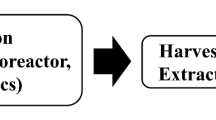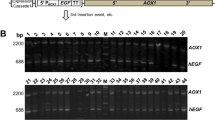Abstract
Key message
The yield of recombinant hEGF was increased approximately tenfold through a range of optimisations. Further, the recombinant protein was found to have biological activity comparable to commercial hEGF.
Abstract
Human epidermal growth factor (hEGF) is a powerful mitogen that can enhance the healing of a wide range of injuries, including burns, cuts, diabetic ulcers and gastric ulcers. However, despite its clinical value, hEGF is only consistently used for the treatment of chronic diabetic ulcers due to its high cost. In this study, hEGF was transiently expressed in Nicotiana benthamiana plants and targeted to the apoplast, ER and vacuole. Several other approaches were also included in a stepwise fashion to identify the optimal conditions for the expression of recombinant hEGF. Expression was found to be highest in the vacuole, while targeting hEGF to the ER caused a decrease in total soluble protein (TSP). Using a codon optimised sequence was found to increase vacuolar targeted hEGF yield by ~34 %, while it was unable to increase the yield of ER targeted hEGF. The use of the P19 silencing inhibitor was able to further increase expression by over threefold, and using 5-week-old plants significantly increased expression compared to 4- or 6-week-old-plants. The combined effect of these optimisations increased expression tenfold over the initial apoplast targeted construct to an average yield of 6.24 % of TSP. The plant-made hEGF was then shown to be equivalent to commercial E. coli derived hEGF in its ability to promote the proliferation of mouse keratinocytes. This study supports the potential for plants to be used for the commercial production of hEGF, and identifies a potential limitation for the further improvement of recombinant protein yields.










Similar content being viewed by others
References
Alemdaroglu C, Degim Z, Celebi N et al (2006) An investigation on burn wound healing in rats with chitosan gel formulation containing epidermal growth factor. Burns 32:319–327
Andree C, Swain WF, Page CP et al (1994) In vivo transfer and expression of a human epidermal growth factor gene accelerates wound repair. Proc Natl Acad Sci 91:12188–12192. doi:10.1073/pnas.91.25.12188
Avesani L, Vitale A, Pedrazzini E et al (2010) Recombinant human GAD65 accumulates to high levels in transgenic tobacco plants when expressed as an enzymatically inactive mutant. Plant Biotechnol J 8:862–872. doi:10.1111/j.1467-7652.2010.00514.x
Avesani L, Merlin M, Gecchele E et al (2013) Comparative analysis of different biofactories for the production of a major diabetes autoantigen. Transgenic Res. doi:10.1007/s11248-013-9749-9
Badri MA, Rivard D, Coenen K, Michaud D (2009) Unintended molecular interactions in transgenic plants expressing clinically useful proteins: the case of bovine aprotinin traveling the potato leaf cell secretory pathway. Proteomics 9:746–756. doi:10.1002/pmic.200700234
Bai J-Y, Zeng L, Hu Y-L et al (2007) Expression and characteristic of synthetic human epidermal growth factor (hEGF) in transgenic tobacco plants. Biotechnol Lett 29:2007–2012
Berlanga J, Prats P, Remirez D et al (2002) Prophylactic use of epidermal growth factor reduces ischemia/reperfusion intestinal damage. Am J Pathol 161:373–379. doi:10.1016/S0002-9440(10)64192-2
Berlanga J, Fernández JI, López E et al (2013) Heberprot-P: a novel product for treating advanced diabetic foot ulcer. MEDICC Rev 15:11–15
Berlanga-Acosta J, Gavilondo-Cowley J, López-Saura P et al (2009) Epidermal growth factor in clinical practice—a review of its biological actions, clinical indications and safety implications. Int Wound J 6:331–346. doi:10.1111/j.1742-481X.2009.00622.x
Buyel JF, Fischer R (2012) Predictive models for transient protein expression in tobacco (Nicotiana tabacum L.) can optimize process time, yield and downstream costs. Biotechnol Bioeng 109:2575–2588. doi:10.1002/bit.24523
Chiapello H, Lisacek F, Caboche M, Hénaut A (1998) Codon usage and gene function are related in sequences of Arabidopsis thaliana. Gene 209:GC1–GC38
Daniell H, Singh ND, Mason H, Streatfield SJ (2009) Plant-made vaccine antigens and biopharmaceuticals. Trends Plant Sci 14:669–679. doi:10.1016/j.tplants.2009.09.009
Datar R, Cartwright T, Rosen C (1993) Process economics of animal cell and bacterial fermentations: a case study analysis of tissue plasminogen activator. Nat Biotechnol 11:349–357
De Wilde K, De Buck S, Vanneste K, Depicker A (2013) Recombinant antibody production in Arabidopsis seeds triggers an unfolded protein response. Plant Physiol 161:1021–1033. doi:10.1104/pp.112.209718
Fu H, Machado Pa, Hahm TS et al (2010) Recovery of nicotine-free proteins from tobacco leaves using phosphate buffer system under controlled conditions. Bioresour Technol 101:2034–2042. doi:10.1016/j.biortech.2009.10.045
Garabagi F, Gilbert E, Loos A et al (2012) Utility of the P19 suppressor of gene-silencing protein for production of therapeutic antibodies in Nicotiana expression hosts. Plant Biotechnol J 10:1–11. doi:10.1111/j.1467-7652.2012.00742.x
Gils M, Kandzia R, Marillonnet S et al (2005) High-yield production of authentic human growth hormone using a plant virus-based expression system. Plant Biotechnol J 3:613–620. doi:10.1111/j.1467-7652.2005.00154.x
Hassan S, Colgan R, Paul MJ et al (2012) Recombinant monoclonal antibody yield in transgenic tobacco plants is affected by the wounding response via an ethylene dependent mechanism. Transgenic Res 21:1221–1232. doi:10.1007/s11248-012-9595-1
Higo K, Saito Y, Higo H (1993) Expression of a chemically synthesized gene for human epidermal growth factor under the control of cauliflower mosaic virus 35S promoter in transgenic tobacco. Biosci Biotechnol 57:1477–1481
Jorissen R (2003) Epidermal growth factor receptor: mechanisms of activation and signalling. Exp Cell Res 284:31–53. doi:10.1016/S0014-4827(02)00098-8
Kudo K, Ohta M, Yang L et al (2013) ER stress response induced by the production of human IL-7 in rice endosperm cells. Plant Mol Biol 81:461–475. doi:10.1007/s11103-013-0016-5
Kuo B, Kusmik W, Poole J (1992) Pharmacokinetic evaluation of two human epidermal growth factors (hEGF51 and hEGF53) in rats. Drug Metab 20:23–30
Lai H, Chen Q (2011) Bioprocessing of plant-derived virus-like particles of Norwalk virus capsid protein under current good manufacture practice regulations. Plant Cell Rep 31:573–584. doi:10.1007/s00299-011-1196-6
Lee KK, Jo HJ, Hong JP et al (2008) Recombinant human epidermal growth factor accelerates recovery of mouse small intestinal mucosa after radiation damage. Int J Radiat Oncol Biol Phys 71:1230–1235. doi:10.1016/j.ijrobp.2008.03.041
Liu J-X, Howell SH (2010) Endoplasmic reticulum protein quality control and its relationship to environmental stress responses in plants. Plant Cell 22:2930–2942. doi:10.1105/tpc.110.078154
Lombardi R, Circelli P, Villani ME et al (2009) High-level HIV-1 Nef transient expression in Nicotiana benthamiana using the P19 gene silencing suppressor protein of Artichoke Mottled Crinckle Virus. BMC Biotechnol. doi:10.1186/1472-6750-9-96
Medrano G, Reidy MJ, Liu J et al (2009) Rapid system for evaluating bioproduction capacity of complect pharmaceutical proteins in plants. Proteins 483:51–67. doi:10.1007/978-1-59745-407-0
Melchers LS, Sela-Buurlage MB, Vloemans Sa et al (1993) Extracellular targeting of the vacuolar tobacco proteins AP24, chitinase and beta-1,3-glucanase in transgenic plants. Plant Mol Biol 21:583–593
Nanba D, Toki F, Barrandon Y, Higashiyama S (2013) Recent advances in the epidermal growth factor receptor/ligand system biology on skin homeostasis and keratinocyte stem cell regulation. J Dermatol Sci 72:81–86. doi:10.1016/j.jdermsci.2013.05.009
Neuhaus JM, Sticher L, Meins F, Boller T (1991) A short C-terminal sequence is necessary and sufficient for the targeting of chitinases to the plant vacuole. Proc Natl Acad Sci USA 88:10362–10366
Nuttall J, Vine N, Hadlington JL et al (2002) ER-resident chaperone interactions with recombinant antibodies in transgenic plants. Eur J Biochem 269:6042–6051. doi:10.1046/j.1432-1033.2002.03302.x
Oh H, Seong J, Kim W et al (2010) Recombinant human epidermal growth factor (rhEGF) protects radiation-induced intestine injury in murine system. J Radiat Res 51:535–541. doi:10.1269/jrr.09145
Parsons J, Wirth S, Dominguez M et al (2010) Production of human epidermal growth factor (hEGF) by in vitro cultures of Nicotiana tabacum: effect of tissue differentiation and sodium nitroprusside addition. Int J Biotechnol Biochem 6:133–140
Paul M, Ma JK-C (2011) Plant-made pharmaceuticals: leading products and production platforms. Biotechnol Appl Biochem 58:58–67. doi:10.1002/bab.6
Plesha MA, Huang T, Falk BW, Mcdonald KA (2009) Optimization of the bioprocessing conditions for scale-up of transient production of a heterologous protein in plants using a chemically inducible viral amplicon expression system. Biotechnol Prog 25:722–734. doi:10.1021/bp.149
Rybicki EP (2009) Plant-produced vaccines: promise and reality. Drug Discov Today 14:16–24. doi:10.1016/j.drudis.2008.10.002
Salmanian AH, Gushchin A, Medvedeva T et al (1996) Synthesis and expression of the gene for human epidermal growth factor in transgenic potato plants. Biotechnol Lett 18:1095–1098
Sharma AK, Sharma MK (2009) Plants as bioreactors: recent developments and emerging opportunities. Biotechnol Adv 27:811–832. doi:10.1016/j.biotechadv.2009.06.004
Silhavy D, Molnár A, Lucioli A et al (2002) A viral protein suppresses RNA silencing and binds silencing-generated, 21- to 25-nucleotide double-stranded RNAs. EMBO J 21:3070–3080. doi:10.1093/emboj/cdf312
Stevens LH, Stoopen GM, Elbers IJ et al (2000) Effect of climate conditions and plant developmental stage on the stability of antibodies expressed in transgenic tobacco. Plant Physiol 124:173–182
Tarnuzzer R, Schultz G (1996) Biochemical analysis of acute and chronic wound environments. Wound Repair Regen 4:321–325
Tiwari S, Verma PC, Singh PK, Tuli R (2009) Plants as bioreactors for the production of vaccine antigens. Biotechnol Adv 27:449–467
Tomaszewska R, Dembinski A (2002) The influence of epidermal growth factor on the course of Ischemia-reperfusion induced pancreatitis in rats. J Physiol 53:183–198
Torrent M, Llompart B (2009) Eukaryotic protein production in designed storage organelles. BMC Biol 7:193–208
Voinnet O, Rivas S, Mestre P, Baulcombe D (2003) An enhanced transient expression system in plants based on suppression of gene silencing by the p19 protein of tomato bushy stunt virus. Plant J 33:949–956
Wang L, Roossinck MJ (2006) Comparative analysis of expressed sequences reveals a conserved pattern of optimal codon usage in plants. Plant Mol Biol 61:699–710. doi:10.1007/s11103-006-0041-8
Wirth S, Calamante G, Mentaberry A (2004) Expression of active human epidermal growth factor (hEGF) in tobacco plants by integrative and non-integrative systems. Mol Breed 13:23–35. doi:10.1023/B:MOLB.0000012329.74067.ca
Wirth S, Segretin ME, Mentaberry A, Bravo-Almonacid F (2006) Accumulation of hEGF and hEGF-fusion proteins in chloroplast-transformed tobacco plants is higher in the dark than in the light. J Biotechnol 125:159–172
Wong W, Huang ER, Wong S et al (2001) Applications, and efficient large-scale production, of recombinant human epidermal growth factor. Biotechnology 18:51–71
Wu HG, Song SY, Kim YS et al (2009) Therapeutic effect of recombinant human epidermal growth factor (RhEGF) on mucositis in patients undergoing radiotherapy, with or without chemotherapy, for head and neck cancer: a double-blind placebo-controlled prospective phase 2 multi-institutional cli. Cancer 115:3699–3708. doi:10.1002/cncr.24414
Wu C, Kuo W, Chang C, Kuo J (2014) The modified rice αAmy8 promoter confers high-level foreign gene expression in a novel hypoxia-inducible expression system in transgenic rice seedlings. Plant Mol. doi:10.1007/s11103-014-0174-0
Yang C-H, Huang Y-B, Wu P-C, Tsai Y-H (2005) The evaluation of stability of recombinant human epidermal growth factor in burn-injured pigs. Process Biochem 40:1661–1665. doi:10.1016/j.procbio.2004.06.038
Yao F, Eriksson E (2000) Gene therapy in wound repair and regeneration. Wound Repair Regen 8:443–451. doi:10.1046/j.1524-475x.2000.00443.x
Yera-Alos IB, Alonso-Carbonell L, Valenzuela-Silva CM et al (2013) Active post-marketing surveillance of the intralesional administration of human recombinant epidermal growth factor in diabetic foot ulcers. BMC Pharmacol Toxicol 3:44. doi:10.1186/2050-6511-14-44
Conflict of interest
The authors declare that they have no conflict of interest.
Author information
Authors and Affiliations
Corresponding author
Additional information
Communicated by Jim Register.
Rights and permissions
About this article
Cite this article
Thomas, D.R., Walmsley, A.M. Improved expression of recombinant plant-made hEGF. Plant Cell Rep 33, 1801–1814 (2014). https://doi.org/10.1007/s00299-014-1658-8
Received:
Revised:
Accepted:
Published:
Issue Date:
DOI: https://doi.org/10.1007/s00299-014-1658-8




